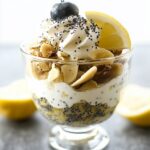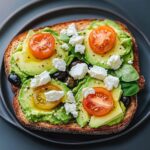This light and slightly sweet Easter Bread is a delightful addition to any holiday meal. The soft, fluffy texture pairs perfectly with both sweet and savory dishes, and it can even be used for French toast the next day. Decorated with almonds and sprinkles, this traditional braided loaf is as beautiful as it is delicious!
FULL RECIPE:
Ingredients
- 1 (1/4-ounce) packet active dry yeast (2 1/4 teaspoons)
- 6 cups all-purpose flour, plus extra for dusting
- 2/3 cup sugar
- 1 1/3 cups milk
- 6 tablespoons unsalted butter, plus extra for greasing
- 1 teaspoon fine salt
- 2 large eggs, lightly beaten, plus 1 for egg wash
- 1/3 cup sliced skin-on almonds
- 1 tablespoon mini white nonpareils
Directions
- Prepare the Yeast Mixture: In a stand mixer bowl, combine 1/3 cup warm water (about 110°F) with yeast, 1 tablespoon flour, and 1 tablespoon sugar. Let sit for 5-10 minutes until bubbly.
- Heat the Milk Mixture: In a saucepan, heat the milk until bubbles form around the edges. Remove from heat and stir in butter, remaining sugar, and salt. Let cool for 10 minutes.
- Mix the Dough: Add the milk mixture and beaten eggs to the yeast mixture. Gradually mix in the remaining flour until a soft dough forms. Beat on medium-high for about 5 minutes until the dough pulls away from the sides.
- Knead & Rise: Transfer dough to a floured surface and knead for 5 minutes until smooth. Place in a greased bowl, cover, and let rise in a warm spot for about 1 1/2 hours until doubled.
- Shape the Bread: Punch down the dough and divide it into 3 equal parts. Roll each piece into a 16-inch rope. Braid the ropes, tuck the ends under, and place on a parchment-lined baking sheet. Cover and let rise for another hour.
- Bake: Preheat the oven to 350°F. Brush the loaf with beaten egg, then sprinkle almonds and nonpareils on top. Bake for 50-60 minutes until golden brown and hollow-sounding when tapped. Let cool for 30 minutes before slicing.
Nutrients (Per Serving, Approximate)
- Calories: 250
- Total Fat: 6g
- Saturated Fat: 3g
- Carbohydrates: 42g
- Sugar: 10g
- Protein: 6g
- Sodium: 150mg
History and Significance of Easter Bread
Easter Bread is a cherished tradition in many cultures worldwide, often symbolizing renewal, celebration, and unity. Rooted in European heritage, this bread is particularly popular in Italy, Greece, and Eastern European countries, where each region has its unique variation. The inclusion of eggs, often dyed in bright colors, represents new life and the resurrection of Christ, making it a staple for Easter Sunday feasts. Traditionally, the bread is braided, signifying togetherness and family bonds.
Variations of Easter Bread Across Cultures
Different cultures have their spin on Easter Bread. Italian Pane di Pasqua is often sweet, flavored with citrus zest and topped with colorful sprinkles, while Greek Tsoureki has a distinct aroma due to the use of mahlab and mastic. In Eastern Europe, versions like Kozunak and Paska are enriched with butter and eggs, resulting in a dense yet soft texture. Some versions incorporate dried fruits, nuts, or even cheese, depending on regional preferences.
Why Easter Bread is Special
What sets Easter Bread apart from other holiday breads is its symbolic and festive nature. The use of eggs in both the dough and as decoration highlights the theme of rebirth and new beginnings. The soft, airy texture makes it perfect for enjoying plain, with butter, or even as a base for a decadent French toast breakfast.
Tips for Making the Perfect Easter Bread
- Use High-Quality Ingredients: Since this is a lightly sweetened bread, using fresh eggs, high-quality butter, and the best flour will significantly enhance the taste and texture.
- Proper Kneading: Kneading the dough well ensures a soft, pillowy texture. Over-kneading can make the bread tough, while under-kneading may result in dense bread.
- Proofing the Dough: Allowing the dough to rise in a warm, draft-free environment is crucial for achieving a light and fluffy bread. Rushing this step may affect the final texture.
- Egg Wash for a Glossy Finish: Brushing the bread with an egg wash before baking creates a beautifully golden and shiny crust.
- Decoration and Customization: While almonds and nonpareils are common, you can also use pearl sugar, sesame seeds, or even add a filling like chocolate or fruit preserves.
The Symbolism Behind Easter Bread
Easter Bread is not just a delicious baked good; it carries deep-rooted symbolism tied to Easter traditions and religious beliefs. The round or braided shape represents unity and eternity, while the eggs—often placed within the dough or served alongside—symbolize rebirth and renewal. In Christian traditions, bread itself holds sacred significance, often symbolizing the body of Christ. The act of sharing Easter Bread with family and friends fosters a sense of togetherness and gratitude during the holiday celebration.
Regional Ingredients and Flavor Profiles
Depending on where it is made, Easter Bread can have unique flavors and ingredients that reflect regional tastes and preferences:
- Italy (Pane di Pasqua) – Often flavored with citrus zest, vanilla, and anise, sometimes incorporating ricotta for a softer texture.
- Greece (Tsoureki) – Uses mahlab (a spice made from cherry pits) and mastic (a resin from the mastic tree) for a distinct aroma.
- Eastern Europe (Kozunak, Paska, Babka) – Enriched with butter, eggs, and sugar, sometimes filled with raisins, dried fruits, or cheese.
- Spain & Portugal (Folar de Páscoa) – Can be both sweet or savory, sometimes featuring layers of meat or sausage for a heartier variation.
Traditional vs. Modern Twists on Easter Bread
While traditional Easter Bread recipes have remained largely unchanged for generations, modern bakers have started adding new twists to suit contemporary tastes. Some popular innovations include:
- Chocolate Chip or Nutella Easter Bread – A rich, indulgent take on the classic recipe.
- Gluten-Free and Vegan Easter Bread – Adjusting ingredients for dietary preferences while maintaining the soft and airy texture.
- Savory Easter Bread – Incorporating herbs, cheeses, and meats for a more robust flavor.
- Miniature Easter Bread Loaves – Perfect for gifting or serving individual portions at holiday gatherings.
Pairing Easter Bread with Other Easter Dishes
Easter Bread complements a wide array of traditional Easter dishes, making it a versatile addition to any holiday table. Some ideal pairings include:
- Egg-Based Dishes: Scrambled eggs, deviled eggs, or an egg salad spread balance the slightly sweet taste of the bread.
- Roasted Meats: Ham, lamb, or turkey pair beautifully with slices of Easter Bread.
- Cheese & Butter: A simple pat of butter, cream cheese, or a drizzle of honey enhances its delicate flavor.
- Fruit & Jams: Fresh fruit, marmalades, or berry preserves add a refreshing contrast to the rich, soft bread.
Serving Suggestions
Easter Bread can be enjoyed in various ways. It is often served as part of Easter brunch alongside other traditional dishes like roasted lamb, eggs, and fresh fruit. It pairs wonderfully with butter, honey, or fruit preserves. Some people also enjoy using it for bread pudding or slicing it for sandwiches with leftover ham. The slightly sweet flavor makes it an excellent accompaniment to tea or coffee.
How to Store and Keep Easter Bread Fresh
To maintain its freshness, Easter Bread should be stored in an airtight container or wrapped in plastic wrap at room temperature. It stays soft for up to three days. If you need to store it longer, freezing is a great option. Simply wrap it tightly and place it in a freezer bag. When ready to eat, thaw at room temperature or lightly warm it in the oven.
Conclusion
Easter Bread is more than just a holiday treat—it is a symbol of tradition, faith, and celebration. Its soft texture, rich flavors, and decorative appeal make it a centerpiece of Easter festivities. Whether you stick to a classic recipe or put your twist on it, this bread is a delightful way to bring family and friends together during the Easter season.






